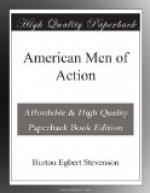The ships were all in fighting trim, with spars housed and canvas furled, and decks spread with sawdust so that they would not grow slippery with the blood which was soon to flow. As the fleet came within range of the forts, a terrific cannonade began, in which the Confederate ships, stationed just inside the harbor, soon joined. One of them was the great ram, Tennessee, and the commander of the leading monitor, the Tecumseh, noted her and determined to give her battle. So he swung his ship toward her and ordered full steam ahead; but an instant later, there came a sudden dull roar, an uplifting of the water, the boat quivered from stem to stern, and then plunged, bow first, beneath the waves.
Farragut, from his lofty station, saw the Tecumseh disappear, and then saw the Brooklyn, the ship ahead of him in the battle line, stop and begin to back. It was an awful moment—the crisis of the fight and of Farragut’s career as well. The ships were halted in a narrow channel, right beneath the forts; a few moments’ delay meant that they would be blown out of the water.
“What’s the matter there?” he roared.
“Torpedoes!” came the cry from the Brooklyn’s deck, for her captain had perceived a line of little buoys stretching right across her path.
“Damn the torpedoes!” shouted the admiral. “Go ahead, Captain Drayton,” he continued, addressing his own captain. “Four bells!” and the Hartford, swinging aside, cleared the Brooklyn and took the lead.
On went the flagship across the line of torpedoes, which could be heard knocking against her bottom as she passed, but not one of them exploded, and a moment later, one of the most daring feats in naval history had been accomplished. Farragut had seen, instantly, that the risk must be taken, and so he took it.
The remainder of the fleet followed the flagship, the forts were passed, and the battle virtually won. The Confederate fleet, and especially the great ram, was still to be reckoned with, but before proceeding to that portion of the task, Farragut steamed up the harbor and served breakfast to his men. Just as this was finished, the Tennessee attacked, and put up a desperate fight, but finally became unmanageable and was forced to surrender.
So ended the battle of Mobile Bay. It left Farragut’s fame secure as one of the greatest sea-captains of all time; great in daring, in skill, in foresight, and with a coolness and presence of mind which no peril could shake. Congress created for him the grade of admiral, before unknown in the United States navy, and the whole country joined in honoring him.
Swinging to and fro with the ebb and flow of the tide at the entrance of Mobile Bay, is a buoy which marks the spot of a deed of purest heroism. A few fathoms below that buoy lies the monitor Tecumseh, sunk by a torpedo at the beginning of the battle, as we have seen, and the buoy commemorates, not the sinking of the ship, but the self-sacrifice of her commander, Tunis Augustus Craven.




